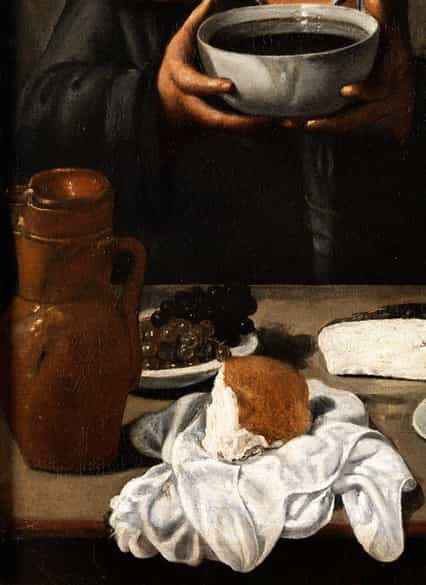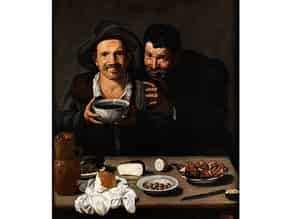Your search for Francisco de Burgos Mantilla in the auction
16th - 18th Century Paintings
Wednesday, 25 March 2015
» reset
Your personal art agent

You are interested in works by Francisco de Burgos Mantilla?
We are happy to inform you, if works by Francisco de Burgos Mantilla are to be auctioned in one of our upcoming auctions.
Please accept our privacy policy
582
Francisco de Burgos Mantilla,
1612 Burgos – 1672 Madrid, zug.
ZWEI BÄUERLICHE MÄNNER VOR EINEM TISCH MIT ARRANGIERTEN SPEISEN Öl auf Leinwand.
101 x 86 cm.
Catalogue price € 40.000 - 60.000
Catalogue price€ 40.000 - 60.000
$ 43,200 - 64,800
£ 36,000 - 54,000
元 312,800 - 469,200
₽ 3,979,600 - 5,969,400
Der Maler lebte bereits seit 1618 in Madrid und studierte unter Pedro de las Cuevas. Er war stark beeinflusst von Velázquez. Das Werk des Malers ist noch nicht gänzlich erforscht. Absolut gesichert ist lediglich ein Stillleben mit trockenen Früchten von 1631, das sich in der Yale University Art Gallery in New Haven, Connecticut, befindet. In seiner Malweise folgt er der Auffassung von Caravaggio, ist jedoch stilistisch eng an das Werk von Velázquez angelehnt, wie auch im vorliegenden Werk deutlich wird. Das Gemälde, das noch stark dem Helldunkel aus der Bildtradition Caravaggios verpflichtet ist, zeigt im Vordergrund eine hölzerne Tischplatte, darauf stilllebenhaft arrangiert links ein hoher Tonkrug vor einer Schale mit hellen und dunklen Trauben. Rechts davon ein Tuch auf dem Brot, Käse, Olivenschüssel, Zitronenhälften sowie eine Wurstschüssel liegen, dazwischen ein Messer. Dahinter links ein Mann, der mit beiden Hälften eine gefüllte Schale hochhält, während er lachend den Betrachter ins Auge fasst. Rechts neben ihm und über seine Schulter blickend ein weiterer Mann, der sich an der Schulter des Freundes aufstützt. So zählt das Gemälde zunächst zu der thematischen Gruppe der „Bodegas“-Darstellungen und steht in engem Bezug etwa zu dem Gemälde „Drei Männer am Tisch“ um 1618 von Diego Velázquez in der Eremitage in St. Petersburg. Auch das Küchenmädchen im „Gastmahl in Emmaus“ um 1617 von Velázquez zeigt bereits diese kompositionelle Auffassung. Am deutlichsten wird der Bezug zu Velázquez jedoch in der direkten Übernahme des links die Schale tragenden Mannes mit breitrandigem Hut auf dem Gemälde „Die Trinker (oder der Triumph des Bacchus)“, das Velázquez 1629 schuf. Der Maler des vorliegenden Bildes hat die Szenerie jedoch aus dem barocken antik-mythologischen Thema wieder herausgelöst und die Figur mit dem Partner ganz in die bäuerliche Sphäre des spanischen Lebens gesetzt. So tritt hier der Gedanken des im Überfluss genießbaren Weines in den ärmlichen Verhältnissen weit lebendiger zu Tage als im Vorbild, in dem die große Weinschale vollgefüllt empor gehoben wird in stolzer Demonstration dem Betrachter gegenüber. Das Gemälde bezieht seinen Reiz aber auch durch die beiden Gestaltungsebenen, indem neben den portraithaften Gestalten hier zudem auch die spanische Stilllebenmalerei in exzellenter Weise vorgeführt wird. Die tonigen Farben, wie wir sie auch bei Werken von Velázquez finden, die sich hier in den braun gebrannten Gesichtern der beiden Bauern wiederfindet, setzt sich in der tonigen Farbigkeit des Stilllebens mit Tonkrug, Maroni, Oliven und Käse fort. So beweist das Gemälde trotz aller Rückgriffe auf Velázquez eine neue bedeutende Eigenständigkeit in der spanischen Malerei der Zeit. (1000703) (11)
Francisco de Burgos Mantilla,
1612 Burgos - 1672 Madrid, attributed
TWO PEASANTS IN FRONT OF A TABLE WITH ARRANGED DISHES
Oil on canvas.
101 x 86 cm.
It is apparent in the present painting that the artist follows Caravaggio's concept in his manner of painting, however his stylistic approach closely resembles that of Vélazquez. First of all, the painting belongs to the genre of “Bodegas” depictions and is for example closely linked to the painting “Three men at a table” (also know as “The Lunch”), painted by Diego Velázquez in 1618 and held at Eremitage in St Petersburg. Furthermore Velázquez' kitchenmaid in the “Supper at Emmaus” (circa 1617) already shows this concept of picture composition. However the most striking reference to Velázquez, is the direct borrowing of the man with broad-rimmed hat, carrying a bowl from the left of the painting “The Drinkers” (also know as “Triumph of Babchus”), which Velázquez created in 1629. The painter of the present painting however extracted the scenery from its Baroque antique-mythological subject-matter and integrated the figure with his partner perfectly into the Spanish peasant realm.
This object has been individually compared to the information in the Art Loss Register data bank and is not registered there as stolen or missing.
Your personal art agent
You would like to be informed of upcoming auctions if a work by Francisco de Burgos Mantilla is offered? Activate your personal art agent here.
Please accept our privacy policy
You would like to purchase a work by Francisco de Burgos Mantilla?
Your personal art agent Purchase in Private Sale Calendar
Our experts are happy to support you personally in your search for art objects.
You would like to sell a work by Francisco de Burgos Mantilla?
Consign now Private Sale Service FAQ
Your consignments are always welcome.
Our staff will be happy to personally assist you every step of the way. We look forward to your call.
Get in touch with our experts
further catalogues Furniture & Interior | Sculpture and Works of Art | 19th - 20th Century Paintings | Silver, Porcelain, Glass, Caskets & decorative Objects | Art nouveau until the 1960s | Russian Art, Boxes and Miniatures | Asian Art, non-european Art, antiquities | The Saxon Treasure | 16th - 18th Century Paintings | Luxury auction | Modern Art | Hampel Living














